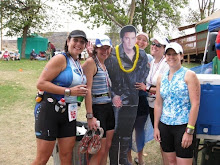Because triathlon is primarily an aerobic sport, there is no need for a triathlete to build rippling muscles capable of producing enormous amounts of force. Since muscle takes significant amounts of energy to cool and carry, there is without doubt a point of diminishing returns as an aerobic athlete builds muscle. I personally began the sport of triathlon from the sport of bodybuilding, and some of my most painful memories of endurance competition come from the soreness, dehydration, overheating and overall discomfort associated with carrying 25 pounds of extra muscle.
But muscle mass is not necessarily synonymous with strength and power. For example, top Tour de France cyclists appear to have toothpicks for legs compared to powerlifters and bodybuilders, yet they are capable of producing nearly superhuman wattage on a bicycle. Champion swimmer Michael Phelps is one of the most powerful athletes in the sport of swimming, but does not appear to have significant amounts of muscle mass compared to other top male athletes in the sport. So how is it that a muscle can stay at a manageable, carry-able size for endurance sports, and yet still be capable of producing strength and power?
The answer lies in the relationship between the nerves, the muscle and something called the motor unit. A motor unit is defined as a nerve and all the muscle fibers stimulated by that nerve. Muscle fibers are grouped together as motor units. If the signal from a nerve is too weak to stimulate the motor unit, then none of the muscle fibers in that motor unit will contract. But if signal is strong enough, then all of the muscle fibers in the motor unit will contract. This is called the “all-or-none” principle.
It doesn’t take much of a signal to recruit slow-twitch, or endurance muscle fibers in a motor unit. It takes a stronger signal to recruit fast-twitch, or explosive muscle fibers. However, the goal of weight training is not to increase the signal to the fibers, but rather to train the body to be able to recruit multiple motor units, whether those motor units are comprised of slow-twitch or fast-twitch muscle fibers. Better athletes have the capability to recruit multiple motor units, which means more fibers are firing, which increases force production.
So, you can have a relatively small number of motor units, but with proper training, can gain the ability to recruit a significant number of those motor units simultaneously. If this is the case, you don’t need much muscle, but just the ability to be able to wholly recruit the muscles that you do have.
Of course, recruitment of multiple motor units is not the only benefit of weight training. Over 20 years of research have successfully demonstrated lower injury rates for the shoulders, knees, hamstrings, low back and ankles in athletes including swimmers, cyclists and runners when weight training was used to strength the soft tissue surrounding and supporting the joints. In some cases, injury prevention is due to correction of a muscular imbalance through the use of targeted weight training, and in other cases, injury prevention is due to the increased ability of a joint to absorb impact.
In addition, weight training can be used to maintain fitness when impact-based exercise is not an option due to a pre-existing injury. For example, triathlete with a foot injury that inhibits running and cycling may still be able to perform single or double-legged variations of the squat or lunge to maintain leg strength, and can also perform non-foot bearing exercises such as the fire hydrant or leg curl. These same exercises and workouts can also be used when it is not logistically feasible to engage in triathlon training. For example, a traveling triathlete may be able to run, but may have to substitute a swim workout for a series of exercises with cables and elastic bands.
Finally, the hormonal response to resistance training is significantly different than the response to endurance exercise. From the perspective of a triathlete, an increase in anabolic hormones such as testosterone may be beneficial for decreasing body fat or improving mood. Studies have shown that endurance trained men tend to have lower levels of testosterone, compared to both sedentary and resistance trained men. A 2003 study entitled “Effect of Training Status and Exercise Mode on Endogenous Steroid Hormones in Males” discovered that compared to an endurance training group and sedentary group, a resistance training group had higher levels of luteinizing hormone, DHEAS, cortisol, total and free testosterone and hematocrit (plasma volume). The take-away message for endurance athletes is that a focus on pure aerobic training with no resistance training may result in a less-than-ideal hormonal response to exercise, which may affect reproductive function, libido, and physical appearance.
Now that you understand that:
- the goal of weight training is not necessarily to build muscle, but rather to recruit muscle
- a proven benefit of weight training is injury prevention
- weight training offers an effective mode of cross-training
- the hormonal response differs between weight training and endurance training





















1 comment:
I love your article for acknowledging the diminishing return of too much muscles on endurance athletes. As a marathoner I've gotten used to the same comments regarding lack of muscle volume to show for my fitness level. I also have calves and legs that would be the envy of body builders and unfortunately in my sport they not only weigh a lot, but are also prone to cramps at the slightest tinge of dehydration. Cheers to lean and mean!
Post a Comment